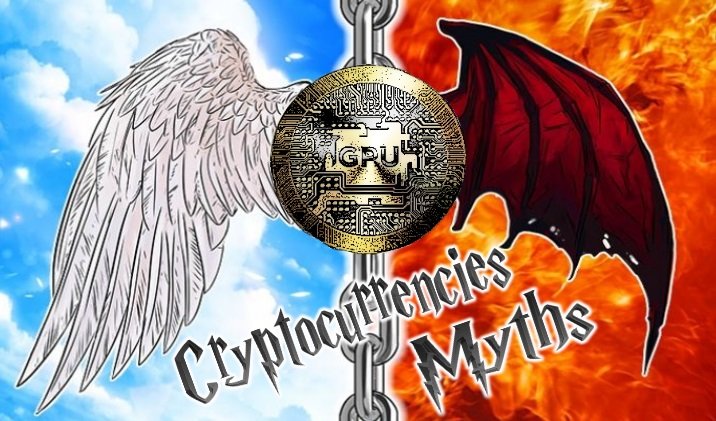
- The 10 Biggest Myths about Cryptocurrencies - Part 2!
- Encouraging Developments for Privacy at Bitcoin and Ethereum!
- Blockchain against Fraud in used Car Sales!
- Tether Hack: $ 31 Million stolen!
- Bitcoin Course Cheallenge Week 7



In the series "The 10 Biggest Myths About Cryptocurrencies", I'd like to take a closer look at the top 10 claims about cryptocurrencies and their opportunities and risks. In doing so, I will daily explore a new myth and check it for accuracy.
Myth 2: States can not regulate cryptocurrencies and will sooner or later ban them
Above all, this myth is found among adherents of conventional financial and economic policy, who prefer a centralized monetary and monetary system controlled by a state and a central bank to a decentralized structure. The accusation is that cryptocurrencies lack an ordering hand by the absence of a central intermediary, which can direct things in the given direction, intervene in case of need, if something does not go as intended and is generally able to curb excesses.
If you take a closer look at reality, you will see that there are actually a lot of different regulatory measures around the world right now. Examples of successful active regulation include the Crypto Valley Zug in Switzerland, which aims to support the development of cryptocurrencies and is already gaining wide acceptance in public institutions, as well as Japan, which has distributed licenses for certain crypto exchanges to set minimum standards and driving dubious providers into illegality.
However, the area currently most affected by regulation is the area of Initial Coin Offerings (ICOs). Almost all governments that deal with the issue have already issued warnings to their respective populations. In a radical move, China issued a general ban on ICOs in the country in September, shortly thereafter South Korea did the same to its big neighbor and also issued a ban. In a further step, China also ordered the temporary closure of all crypto exchanges operating in the country.
Again, one can, however, with alternative measures against it. In Canada, for example, there is a regulated ICO where the state collaborates with a blockchain start-up to conduct a token sale.
Therefore, this myth can be said: Even if states have no patent recipe for the regulation of cryptocurrencies in hand and there are countries that resort to partial bans, there are also examples that show how it to a long-term and crypto-friendly regulation can come. The chances of such regulation are good, as there will always be countries, and especially offshore financial centers, that have a liberal attitude towards the crypto-economy. As a result, there is mounting pressure on global governments not to force too restrictive crypto policies to provoke capital outflows and loss of control to offshore financial centers.
HERE you can read Part 1


Over the last few months, some exciting privacy technologies for Bitcoin and Ethereum have been further developed and improved: Confidential Transactions, Reusable Payment Codes, zkSNARKs and Ring Signatures. This revives the hope that cryptocurrencies will give humanity financial privacy.
If you are unaware, it's time for you to know: cryptocurrency privacy is usually a tragedy. If you look at the two strongest cryptocurrencies, Bitcoin and Ethereum, you should realize that there is nothing private here. And this is not an accident or accidental happening, but the logical consequence of the basic concept of cryptocurrencies.
The whole idea of Bitcoin and other cryptocurrencies is that every node in a decentralized network checks the validity of each transaction and block. In order to do this, everyone must be able to see who has sent how many coins to whom. Everything has to be completely transparent. This does not seem to have much to do with privacy and anonymity.
When you transfer money with a blockchain like Bitcoin or Ethereum, you should be aware of the following: Not only your business partner, your bank, and the government know what you do - everyone. And, worse, thanks to Blockchain analysis techniques, not only does everyone know about your last transaction, but they'll also be able to link your various transactions and addresses and inputs to find out what's going on in your wallet.
The situation is not very pleasing. Cryptocurrencies are still regarded as a particularly private means of payment. But it does not take much imagination to imagine that they will be the trailblazer of the financially absolutely transparent citizen. To prevent this, crypto currencies are being developed on the one hand, which, like Monero and Zcash, offer better privacy. On the other hand, technologies are being created that improve privacy on blockchains such as Bitcoin or Ethereum. These will be the subject of this article.
Specifically, these are the following technologies:
- Confidential Transactions
- Reusable Payment Codes
- zkSNARKs
- Ring Signatures

Confidential Transactions:
To understand what Confidential Transactions do, you might start by imagining that you are playing rock paper scissors by email.
Of course it is nonsense: If you write to me by e-mail that you have a stone, I answer "paper", and if you write that you have a " scissors", of course I will have a stone. As long as the two players are not present and set their bid at the same time, the one who moves first loses.
However, cryptographers have long developed a method for playing rock paper scissors, coin throws or poker by e-mail. To do that, one needs so-called "commitments" - these are functions with which one can fix a certain value ("scissors", "head", "four kings"), but keep it secret until it is revealed. You can think of it as if you wrote the result on a piece of paper, put it in a box, give the box to the partner, and then, when it comes to the revelation, hand over the key. With hashes or encryption, it's relatively easy to make such commitments.
But if we try to apply the same to Bitcoin, it gets a little harder. The idea of Confidential Transactions is to keep the amounts sent in a transaction as secret as the commitment to e-mail coin toss, but at the same time to allow all nodes in the network to verify that the transaction is correct. It's similar to sending an encrypted commitment to scissors paper by email, but the email provider can check if I make a valid bid or something nonsense like "Well". Absurd, right?
The whole cryptographic magic of Confidential Transactions lies in resolving this paradox. The concept was suggested by Adam Back. Gregory Maxwell has further developed it, and it was first implemented in Blockstream's Elements Sidechain. In a text file, Maxwell explains what the trick is: by using different cryptographic technologies, such as Pedersen Commitments, it becomes possible to offset the inputs and outputs - even if they are obfuscated.
But if we try to apply the same to Bitcoin, it gets a little harder. The idea of Confidential Transactions is to keep the amounts sent in a transaction as secret as the commitment to e-mail coin toss, but at the same time to allow all nodes in the network to verify that the transaction is correct. It's similar as if I were sending an encrypted commitment by rock paper scissors by e-mail, but the email provider can check if I make a valid bid or something nonsense like "Well". Right?
The whole cryptographic magic of Confidential Transactions lies in resolving this paradox. The concept was suggested by Adam Back. Gregory Maxwell has further developed it, and it was first implemented in Blockstream's Elements Sidechain. In a text file, Maxwell explains what the trick is: by using different cryptographic technologies, such as Pedersen Commitments, it becomes possible to offset the inputs and outputs - even if they are obfuscated.
A valid transaction covers inputs and outputs (less fees). So, if you calculate the formula "Inputs - Outputs", only the fees are left over. The special thing about the commitments of Confidential Transactions is that it is possible to subtract them without knowing their exact content. You can think of it as the equation "(4 + 3) - (5 + 2)". It has the same result as "7 - 7".
Confidential Transactions disguise the amount sent in a Bitcoin transaction. However, they do not disguise who sends and who receives, which is why they are not a panacea against data breaches. However, they can be part of a comprehensive solution. For example, the combination of CoinJoin and Confidential Transaction could result in almost complete anonymity.
It should be possible to enable Confidential Transactions via Softfork for Bitcoin. As with SegWit, one would wrap the transactions in an anyone-can-spend address. Unlike SegWit, clients without an update would not know that bitcoins were being moved, so the consistency of the nodes to the UTXO set would be gone. Another disadvantage of Confidential Transactions is the size of a transaction. As Maxwell explains, Confidential Transactions would inflate the size of the transaction 60-fold, that is, to around 10 kilobytes.
Now, two Stanford University cryptographers Benedikt Bünz and Jonathan Bootle have teamed with Blockstream to try and get Confidential Transactions smaller. The impressive result Maxwell recently introduced in the Bitcoin mailing list: An algorithm called Bulletproof reduces the bloat factor to ~ 3x of the current transaction pattern. Since this approach scales logarithmically to the number of inputs, CoinJoin makes the bloat factor extremely small. If you connect about 64 transactions, the proof will still be smaller than 1.1 kilobytes, which makes the extra space of proof negligible. "
Core developer and Blockstream employee Pieter Wuille comments on the breakthrough: "Bulletproofs are an amazing discovery that fundamentally changes what's possible." However, it's hard to predict if and when it will create Bitcoin's Confidential Transactions - not least because they fundamentally change some aspects of Bitcoin that are not completely irrelevant regulatory.
Reusable Payment Codes:
One of the standard recommendations for Bitcoin users is that you should never use the same address multiple times. The reason for this is mainly that it would reveal too much about his privacy. Therefore, you can create a new address at bitcoin.de for each deposit. Does not everyone know how many Bitcoins are on your wallet?
In many cases this is an inconvenient requirement. For example, if you, like me, have a donation address on a blog, keep getting payments from a party or person, or just have no access to the wallet, but still want to issue a payment request.
The recently released Android SPV Wallet Stash, available for Bitcoin and Bitcoin Cash, offers a solution to this problem: it has implemented reusable payment codes as described in BIP 47. "Our innovative payment address gives users a single, reusable address for payments and messages, which prevents blockchain observers from seeing the history of transactions," the wallet developers explain.
How does this work? Basically similar to the HD wallets (hierarchical deterministic wallet) that produce a basically almost infinite number of keys and addresses from a master key. Anyone who knows the Reusable Payment Code can generate any number of addresses for which the owner of the code has the private key. In order to ensure that the recipient knows who has sent him something, in the first transaction he builds a kind of "tunnel": In it he publishes his own paycode, with the help of which he derives addresses from the Reusable Payment Code. Thus, it is possible for the receiver to identify the sender, even though this money transfers to outwardly unrelated addresses.

Ethereum's approach to increase privacy is slightly different. After the first part of Metropolis hardfork (Byzantium) has been completed, it is possible to process more complex cryptographic operations in smart contracts. This allows you to increase privacy within the contract with certain technologies - while the normal ether transactions remain fully transparent.
The two currently discussed and tested technologies are zkSNARKs and Ring Signatures.
zkSNARKs:
zkSNARKs are the zero-knowledge proofs used by Zcash. "Zero-knowledge proofs allow one party to prove to another that a statement is true without revealing more information than the statement is true," explains the Zcash website.
So, just like Confidential Transactions, zkSNARKs are much more far-reaching: while Confidential Transactions can only unseen the correctness of transaction amounts, zkSNARKs can conceal and validate any kind of information. Zcash uses them to "check the validity of a transaction according to the rules of network consensus without revealing any of the information on which the calculations are based." This is possible by "encoding some of the network's consensus rules in zkSNARKs . "
Thus, transactions sent with zkSNARKs are completely anonymous: they not only hide the amount sent, but also the sender and recipient - while the other nodes in the network remain able to confirm that the transaction is correct.
With Ethereum, the zero-knowledge proof can not be used for normal ether transactions. However, since Metropolis hardfork, it has been possible to use it to disguise the contents of a smart contract. For example, one can take an ERC20 contract to create, send, and receive tokens, and then cloak the operations in the contract, such as the transfer of tokens. The miners and knots then know that a function is running within the contract, and that everything is going well, but they do not know what exactly is going on.
Another possible application would be election contracts: anyone who is registered in a smart contract can cast a vote, and you can determine what the result of a poll is and that each has a maximum of one vote - but you can not understand who voted for something. If you intend to map democratic elections on a blockchain, this would be a condition.
How exactly zkSNARKs work is a complicated topic. There are interesting technical introductions on the website of Zcash, a series of three parts by Vitalik Buterin and an introduction by Christian Reitwiessner of the Ethereum Foundation. There is already a library called ZoKrates, which implements zkSNARKs for solidity. Its author, Jacob Eberhardt, has already predicted that there will soon be plenty of "Zapps" - private decentralized applications on Ethereum.
However, zkSNARKs also have a downside: they require a lot of space and computer resources. A first demo implementation showed that running a zkSNAKRs contract is very expensive. The cost of gas was about $ 10. Even with the enhancements amazingly introduced by ING, zero-knowledge-proofs continue to be quite expensive.
This is where we need to talk about Ring Signatures.
Ring Signatures:
Ring Signatures are the basic technology of the quite private cryptocurrency Monero. Ring signatures were first introduced in 2001. They are a cryptographic technology for signing messages in a way that you can verify that they have been signed by a member of a group, but can not tell who exactly.
At Monero, the Ring Signatures are used to sign transactions in exactly this way: An observer can confirm that the signature is valid because it can be assigned to a group of potential subscribers, but it is not possible to specifically identify the sender of the transaction to determine. Monero breaks the chain of transactions.
Recently, a developer used the Metropolis-enabled cryptographic operations to sign functions with Ring Signatures within a contract. The contract published in the Ropsten Testnet is a kind of mixer. While it can be said that the contract is sending a valid transaction to the outside, it remains unclear which member of the contract has done so. This is possible with both Ether and ERC20 tokens.
It is possible that in the near future, Ring Signatures will also create a contract on Ethereum's live chain. Maybe as part of a more complex, decentralized mixer for Ethereum. However, Ring Signatures are not as effective as zkSNARKs in breaking the chain of transactions, as there are some possible attacks on the privacy of Ring Signatures. However, the cost of running the contract is significantly lower than that of zero-knowledge-proofs.


According to a study by the EU, the so-called "odometer fraud" is a widespread problem in the European Union. Many dealers and buyers of used cars have to deal with the consequences of the problem. Especially when scammers have manipulated the odometer to make the car look younger. The blockchain technology should help.
Odometer fraud with European used cars
According to the study, consumers are the least trusted in second-hand car trade compared to other sectors. This is mainly because of the fact that odometer readings are often manipulated. After the purchase, it often turns out that the used car has suddenly traveled much more miles than you could read from the odometer.
The manipulation is very simple - starting at just under 50 euros, you can order "Odometer Correction Services" on Ebay - and simply correct the mileage of the car to the desired mileage. This can have some inconvenient consequences.
According to a study involving Germany, France, the Netherlands, Belgium and Luxembourg, these states only account for between 5% and 12% of purchased second-hand cars - as long as they are intra-country trade. However, as soon as trade crosses borders, this number will then expand significantly. Already one has to deal with values between 30 and 50%. The estimated economic damage for this problem is between 5.6 and 9.6 billion euros across the EU.
Blockchain against fraud
Now the EU wants to tackle the problem with the help of Blockchain. Above all, the technology should create more transparency in this respect, despite the protection of privacy. For example, you could compare the mileage and GPS data decentralized without having to use personal data.
The technology is also interesting with regard to the autonomous transport of people. The blockchain could create a kind of superior database that collects, compares and archives the information about the different vehicles - of course anonymously and securely. Already existing solutions collide namely, according to study with the data protection laws, especially in Germany. With the automated comparison of the data by Smart Contracts the data of the used cars could thus be easily adjusted. That would increase the security of the used car purchase, without violating the privacy rights.
A corresponding draft of a German company already exists - the CarPass. This is a data card for motor vehicles, on which data is encrypted using the blockchain. Distributed data collection makes them accessible from anywhere. The Bonn based company is also already working on the CarPass Meter, which focuses on manipulating (and preventing) mileage.


According to the Tether, around USDT 31 million has been stolen as part of a hacker attack on the Tether Treasury Wallet. This is one of the biggest hacker attacks in the crypto scene since the DAO hack last year.
As Tether announced in a critical announcement, a total of $ 30,950,010 was illegally removed from the Tether Treasury Wallet by a malicious attack on November 19 and sent to an unauthorized Bitcoin address. The value of the stolen tokens is (almost) exactly the same value in US dollars, as the goal of the cryptocurrency is to provide an accurate representation of the current price of the US dollar.
In response to the theft of the tokens, Tether has marked the affected coins to make the circulation traceable and prevent the holders from trading or issuing the USDT. So Tether wants to work to get the tokens back. It is expressly cautioned against using the stolen tokens in any form, as they would not be accepted and no equivalent would be given to them.
Furthermore, Tether has taken several steps. For one thing, the Tether backend wallet service has been suspended for the time being to conduct a thorough investigation of the incident and prevent future recurrence. On the other hand, the Tether community is to be provided with an update for the Omni Core software, which is used to perform omni-layer transactions. The innovations are intended to prevent the transfer of stolen coins from the thief's wallet. Tether urges all network participants to integrate the software as soon as possible to prevent further damage to the overall network.
The cryptocurrency tether is preferably used by crypto exchanges to facilitate the exchange with fiat currencies. According to the company, 100% of the tokens are covered by Fiat currencies. With a market capitalization of just under 675 million US dollars, Tether is currently ranked 20th of all cryptocurrencies.


Don't miss your CHANCE to Win 💰 20 Whaleshares + 40 Hairshares💰 in the 🏆BITCOIN COURSE CHALLENGE Week 7🏆
How and where to participate? Just click HERE!


I wish you all a lovely Tuesday!!!
ⓁⓄⓥⒺ & ⓁⒾⒼⒽⓉ
Best regards
@danyelk
.gif)


